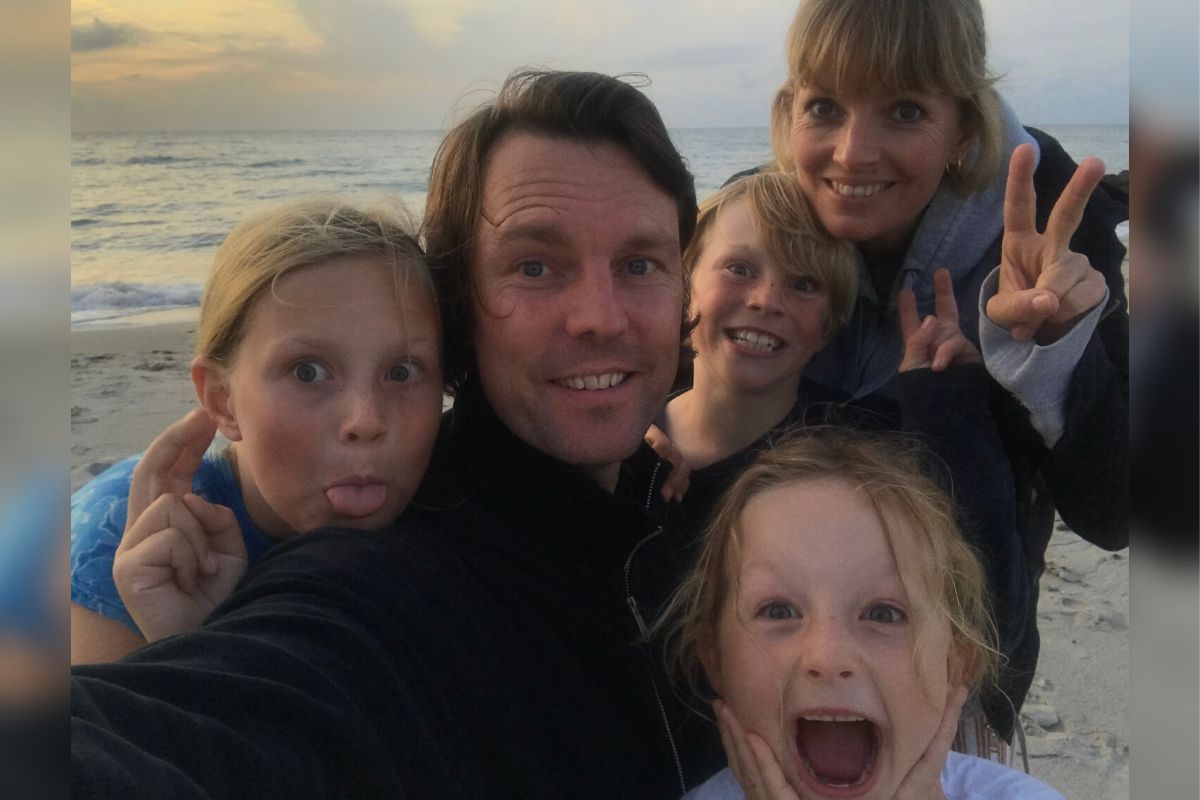Meet Jennifer and Andrew, Annemieke and Michiel, Marta and Arek. They all manage big careers and busy households. We spoke to them to find out how they’ve negotiated the “who does what” to raise children, forge careers, and keep a good life running.
We ditched ‘breadwinning’ for ‘breadsharing’
Jennifer, National Marketing Manager at an Australian corporate, and Andrew, a director with the Australian government, live in Canberra, Australia, with their three girls Anna (14), Stella (11), and Mary (nine). They’ve had a few different set-ups as they’ve raised their three girls, and have worked out how to run things through a series of conversations.
In their early child-rearing years, Andrew was the breadwinner and Jennifer took time out from her career to run the household and take primary responsibility for looking after their daughters. “When we had our first child, we both assumed that I would stay with the baby and my husband would work. There wasn’t a lot of discussion. We’d both grown up in families with that model and we didn’t consider an alternative,” says Jennifer.
They had a long discussion about budgeting and then followed up with a few more to work out the rest. During these talks, they worked out that Andrew needed to find a job that would earn enough for Jennifer to leave paid employment. They knew that would probably mean moving cities — they did. “We both felt great about doing whatever was needed to set up that family structure,” says Jennifer.
Jennifer stayed at home until their youngest was about one. And then it was clear it was time for her to return to her career. “I realized that I wanted to work because I felt vulnerable and lonely. I was really open about this with my husband and we just kept making small adjustments,” she recalls.
“I worried that if I went to work the children would be worse off and that my salary wouldn’t cover child care. My husband was more evolved in his thinking. He often said that the kids would be best off if we were both happy. He also emphasized many times that my work wasn’t just about covering costs. It was an investment in me. It’s so true. Today I can earn a better salary because I didn’t give up my career entirely. Interestingly, it took me longer to realize this than my husband,” says Jennifer.
Andrew adds, “The main consideration was, what was going to be most fulfilling for us both individually and as a couple. It’s like the oxygen mask instructions on a plane — sort yourself out first so you can look after others. That was our approach,” he said.
And Jennifer’s move back into her career has been a good one. “I loved going back to work. I worked harder than I’d ever worked before and I felt like I was a ‘someone’ again. It was a leap to return to full-time work, but I’ve never regretted it,” says Jennifer.
Andrew describes the “important shift” their family experienced at the time, “Jen introduced me to two concepts. The first was the ‘mental load’, a term used to describe the weight of all the thinking, planning and organizing that goes into running a household. When the penny really dropped for me on just how significant this load is, I realized I needed to do more at home and got to it.”
The other key concept Jennifer told Andrew about was ‘breadsharing’. ‘Breadsharing’, as opposed to ‘breadwinning and staying at home’ was first defined in research done by Associate Professor Erin Reid of the McMaster University’s DeGroote School of Business. Reid defines a breadsharer as a “husband who values enabling each partner to pursue their work and family goals.” Her 2018 article on the topic is well worth a look.
Andrew continues, “We decided that I’d make the shift from being a ‘breadwinner’ to being a ‘breadsharer’. It allowed me to take pressure off myself in the work context (which has actually helped at work) and contribute more to running things at home. We’ve struck a better balance and our combined incomes are significantly more than I could have ever earned alone. It’s great!”
Jennifer and Andrew both emphasize that their arrangement only works because of the flexibility their employers provide. Jennifer’s employer is genuinely committed to workplace flexibility. She’s based in the workplace and can work remotely if something urgent comes up. Andrew’s employer is, in his words, “moving towards more flexible work practices.”
“Part of my challenge is to use the flexibility and not feel worried about any potential negative perceptions — it’s a work in progress for me,” he says.
And yes, there are times when the struggle is real for the Ramsay family. And when it all gets a bit much, they’ve got each other’s backs.
“Things often get overwhelming and sometimes one of us starts to feel ‘over it’!” says Jennifer. “Andrew and I have good instincts for when the other person has reached that point and we’re supportive of each other. Just knowing that can keep you going.”
Andrew adds, “When the pressure is on we buy some essential help: cleaner once a fortnight, gardener once a month, after school care one day a week.”
Staying active and connected with their friends is also a non-negotiable for the couple. Andrew incorporates physical activity into his routine at least three times a week, including a weekend round of golf, while Jennifer runs with friends three mornings a week, “We chat about everything from the family to work and what’s on telly and in the news. It’s my social time and I’m exercising too so it’s great for improving my outlook on life.”
Jennifer and Andrew’s tips
For working out who does what:
- Explore together what is going to be most fulfilling for you both, individually and as a couple.
- It can take a series of conversations, big and small. This is what worked for us. We worked it out over time.
- Remember the oxygen mask instructions on a plane — sort yourself out first and then you can look after others.
On how to manage the juggle:
Jennifer:
- Don’t expect to manage the juggle. It’s not really possible.
- Cancel plans when you’re overwhelmed; just pare it back to the essentials.
- Teach kids to help and run their lives. Expect that they are capable little people.
Andrew:
- Buy support around the house: cleaning, gardening, whatever.
- Prioritize family time: eat dinners together, plan holidays and try to spend some one-on-one time with your kids. It’s not good enough to get home tired, flop on the couch with a beer and expect your kids to engage.
- Try to keep healthy both physically and mentally by doing some regular exercise—particularly with friends. The exercise does wonders for your outlook, and time with friends provides much-needed perspective.
Dialing down work to handle bumps in the road
Over on the other side of the world, Michiel, Digital Design Manager, and Brand Developer, and Annemieke, Administrative Assistant, are managing the juggle in The Hague, The Netherlands. They live by the beach with their three children, Milou (11), Tigo (nine), and Janne (six), and have also had a journey to find the best way to manage work and family life.
“Becoming parents and finding the right balance is hard work and quite the struggle. You have to work it out as you go,” says Annemieke.
Annemieke was in a management role before she had children. After experiencing postpartum depression and anxiety after their first child was born, she left her demanding role to find work that was a better fit for her new reality. “Getting the right fit was hard,” she remembers. “The fact that I suffered from severe postpartum depression and anxiety forced us to speak about our plans and future.”
“We both want our kids to grow up with parents that can be there for them. That made us realize that for us, the best way to manage things would be for one parent to work full-time and the other part-time.”
And that decision didn’t require much discussion. “I guess we are lucky because I was able to be the one who could work part time, so there was no discussion there. I never wanted to work full time because I also wanted to be at home with my kids,” says Annemieke.
“Being open and communicating about our struggles helped us a lot,” adds Michiel. “Talking helped me to get through what needed to be done and create time and space to be at home with Annemieke and the kids when needed.”
Annemieke’s return to work after their first child went well. Even though it was four days a week, having fewer responsibilities suited her.
And then things changed. When she was pregnant with their second child, new management took over her department and it became clear it was time for her to leave the organization. She found a new management job and “that’s where things went wrong,” tells Annemieke. “I felt stressed, lacked sleep, and feeling responsible for our new family of four caused me to have burnout. I suppose that was the hardest time. Once again I had to leave my job, which felt horrible.”
The couple had lots of talks, arguments, and tears about how things had become so hard. It took a big effort from both sides to work out how to get life back on track. Annemieke: “Michiel had to step up to keep his job and keep the family going. Open communication was very important for us. We had to respect each other and be patient.”
They decided that Annemieke would work from home to give her and the family more rest. “I started a vintage web store — once just a hobby. We worked on the store together which was nice,” says Annemieke.
At that time, Annemieke fell pregnant with their third child. “A happy surprise, yet also a very exciting, anxious time for us as a family. When our daughter was born, things went well for us,” she smiles.
“When Janne was six months I felt like going back to work, to an office with colleagues. I found the job that I am in now, and that came at the right time. It was three days and at a level I felt I could combine with our family life. “
Like Andrew and Jennifer, Michiel and Annemieke highlighted that workplace flexibility is essential to make it all work. “I have a job that, when needed, I can work from home,” says Michiel. “That gives us flexibility so that when one of the kids gets ill, I can be there to take care of them and also work.”
The Dutch couple keeps fit and healthy to help make things work. Annemieke is a regular at ‘Mom in Balance’, an outdoor boot camp. “I really need and enjoy it,” she enthuses. “I’m lucky to live so close to the beach and have a great trainer and fun ladies to work out with.” Michiel loves to cook and finds his Zen making tasty healthy meals. “It’s my time of the day, my ‘Dad in Balance’ moment,” he smiles.
Annemieke and Michiel’s tips
For working out who does what:
- Be open with each other. Talk about your dreams.
- Take the opportunity to grow through the hard times.
- Respect and patience are key.
On how to manage the juggle:
- Remember that the job you have, or the position you are in, doesn’t have to be forever.
- Enjoy your kids and watching them grow up.
- Try to stay healthy, mentally, and physically.
Tag-teamed in and out of their careers
Also based in The Netherlands, originally from Poland, Marta and Arke have managed a lot as they’ve had a family and built their working lives. They’ve tag-teamed in and out of their careers and also moved countries while raising their three children, Stas (12), Hania (10), and Kazik (seven).
When talking about working out who does what, Marta is quick to point out that for them, it wasn’t the initial discussion to work things out that was hard, it’s what came next that has sometimes been difficult.
“Honestly speaking, the discussion itself was never the hardest part for us. Each and every time we were very optimistic in terms of how things would be. It was what came next that was more difficult. So adjusting, communicating, being compassionate and understanding afterward — that’s the most difficult part,” says Marta.
When Marta was pregnant with their first child, they lived in Poland, both worked full-time and earned about the same. When Stas was born, Marta took five months’ parental leave from her work at an NGO. As her leave came to an end, they talked about how they’d manage things. Both were keen to stay home with their baby son! Marta decided that it was only fair that Arke got to have time with him as she’d had her parental leave.
“We didn’t have any big negotiations about who would do what at this point. It was more of a gentle talk going through the pros and cons and what would work best for everyone. The considerations were mainly financial,” says Marta.
“In terms of priorities, we were very aligned. The kids come first. The discussion was more about the logistics and responsibilities, rather than priorities, which I think is way easier.”
Arke left his work at T-Mobile and stayed at home with their son until he turned one. After they celebrated Stas’ first birthday, Arke returned to work and Marta’s mother stepped in to help.
And then came a curveball. As the couple was getting ready to welcome their second child, Marta lost her job. She was the primary earner at this time and this loss meant she was out looking for a job within two weeks of giving birth. While she was successful in landing a new position, she wasn’t happy. “I was breast-pumping a lot and continuously looking for another solution,” she remembers. Again, they solved it with teamwork and family support. Arke went back to work, Marta got another role working flexibly, and her mother stepped in to help.
Everything changed for Marta and Arke when Marta got a full-time job at the large corporation where she works today. They agreed Marta would work full-time at the office and Arke would work full-time at home.
They batted on, however, and Marta’s position gave them the salary and space to plan and have their third child. A few years later, her role took them to The Netherlands.
Their model works well, but Marta shares that they can fall into the “who has it harder” dynamic. “I remember having some discussions when I complained to my husband that he wasn’t fully understanding the stress and pressures I face at my work, while he was complaining about the physical and emotional drain caused by a lack of sleep and the physical effort of taking care of our children. So at those moments, it was very easy to get angry, annoyed, and fall into the trap of thinking that your partner has it better. I envisioned him having a joyful and playful time. He envisioned me drinking coffee all day long. Now we laugh about it, but when you are tired and angry it is definitely not funny. The only way to get through is to discuss, explain, and be compassionate.”
And the conversation about ‘who does what’ is an ongoing one. “Especially with children, the situation is so dynamic, it changes so much, that you have to adjust and check whether we are still happy doing what we do,” says Marta. “So we talk about it a lot, and check in with each other about how we feel.”
Marta and Arke’s tips
For working out who does what:
- The initial discussion on who does what isn’t necessarily the hardest part. It’s what comes next that can be the most difficult. This takes adjusting, being compassionate, and understanding.
- Keep communicating. Things keep changing. It’s an ongoing process.
- Once you’ve decided who does what, don’t fall into the trap of thinking the other person has it better. You’re both facing different challenges.
- Give each other space to do the things you love with the people you enjoy being with, i.e. a weekend away with friends.
On how to manage the juggle:
- Clarity, especially with the chores. When it’s clear who does what and why there’s no further discussion.
- Don’t assume. Talk. Discuss things.
- Respect your work, whether at home or outside, physical or intellectual. Both can be equally exhausting.
Marta adds, “Love, respect, and communicate, and everything else will be OK.”









